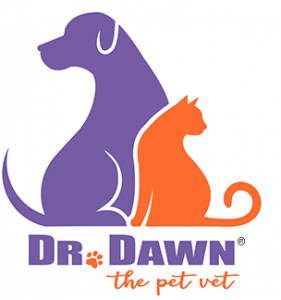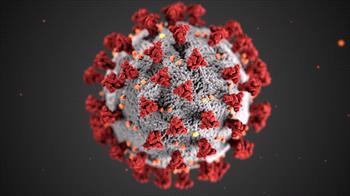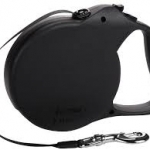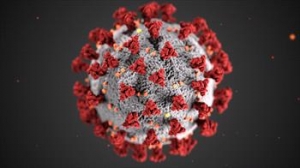
All of us have questions about how to stay safe and avoid exposure to coronavirus. Those of us with pets may be getting mixed messages in the media. This blog is intended to address common questions, with updated information from reliable sources. All the information was obtained from the sources referenced below.
FAQ’s:
Where can I find more information about COVID-19 that I can understand?
My advice is to limit your online searches and sources of information to a few reliable references.
I recommend three references:
CDC
Worms-and-Germs Blog
WHO
Can SARS-COV-2 infect dogs, cats and other animals (updated 4/1)
The experts are still not clear on that answer. There have been no cases of transmission from animals to humans documented. Experts are still investigating two dogs and two cats, which tested positive, that had prior been exposed to infected people. Ferrets have been infected experimentally and their symptoms are being evaluated, to see if they clinically develop the disease. Experts are still not sure if pigs can be infected. Until those studies are done, mini-pig pets are in a gray zone.
By referring to the animals testing positive, we describe them as “infected”. But that does not confirm that they can develop the same symptoms and disease progression. It does mean that they can produce live virus that may infect other cats, ferrets or, potentially, people. We know that dogs can become infected, but they might not be able to infect others. Until that is known, the following precautions are recommended.
It is most important now is to isolate yourself and your pets, minimizing exposure. The main concern, based on the information known at this time, is whether or not your pet can transmit the virus to you from their coat. To rule out that possibility, I recommend bathing your pet if there has been interaction with other people or dogs.
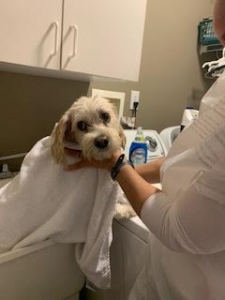
This is a photo of me bathing my dog. I recommend leaving the shampoo, lathered, on for 10 minutes. I am wearing a plastic garbage bag here, and had worn gloves. I wore the plastic over my clothes to make sure I didn’t get wet. A change of clothes immediately after should also be fine, and instead of wearing a bag. I took the gloves off by this time in the photo because I was drying her, and had switched towels, and completed the actual bath. Any shampoo will do, but one with chlorhexidine is great if you have it, or a non-drying dog shampoo such as one containing oatmeal.
This is particularly important if you have been given the responsibility to care for the pet of someone infected and quarantined. Bathe the pet before taking the pet into your home. Extra precaution is recommended when caring for cats and ferrets from COVID positive patients.
How to care for your pets when you have COVID-19 (updated 4/3)
The risk of exposure to pets is mainly a concern that they can transfer virus from you to other human members in your household. As said, the degree of this risk is still being investigated and determined. And, pets exposed may track the virus out of the household on their coats.
The goal is to keep exposed animals away from unexposed people.
If you are sick, stay away from your animals just like you would other people. However, if you have COVID-19 and have been around your pets, keep them inside and away from other people. This includes other people in your family who are not infected. If you are self-isolating, so is your dog/cat/ferret. If your dog or cat is infected by you, they probably will not show signs.
If possible, your now infected dog should be walked by the infected person. Do so in an enclosed space (e.g. your yard, but away from neighboring dogs) and only for purposes of eliminating. Walks for exercise are out until the person recovers and is no longer shedding the virus (tests negative).
If the infected person is too sick to do this, other household members should take out the dog that is being isolated with the infected person. If one or more household members have recovered from the infection, they should do it- as they’re likely immune to reinfection.
If there are no recovered people available, and the infected person is too sick, then nominate a household member to do the pet care. The dog should remain isolated with the sick person, not roam free throughout the house. This person responsible for the dog should wear gloves, and not allow the dog to lick them, particularly on the face or hands. You do NOT need to wear disposable gloves. Dish-washing gloves are fine. Wash the gloves carefully, or use rubbing alcohol to clean them after the walk, and then they should wash their hands for at least 20 seconds after removing the gloves upon returning from outside and returning the dog to the isolation area with the infected person.
The risk of transmission from a dog leash is low because the dog is unlikely to have secreted virus onto it, unless the dog chews the leash. If so, wash and disinfect the leash as well.
Dog bowls should be cleaned periodically with detergent and water, after which hands should be washed or disinfected. Remember, pet mouths can carry infected saliva. Do not touch or handle the bowl while dispensing food; if you do, wash your hands immediately.
Cats and ferrets are easier to keep indoors, and the infected person, if able, should care for them. If the infected person is too sick to care for them, gloves would be worn when handling the cat, food and water bowls, litter boxes and ferret condos. Avoid touching the cat or ferret. Again, kitchen gloves are fine, and the same directions for glove care apply here.
All these precautions will not guarantee protection, but will reduce the risk.
Cat pets serve as fomites (objects that transfer the virus)?
COVID-19 appears to be primarily transmitted by contact with an infected person’s bodily secretions, such as saliva or mucus droplets in a cough or sneeze. If that secretion touches a surface or object, and then a person touches it, the virus can transfer to the hand. If that hand then touches their face, nose, or possibly eyes, it risks infection.
Smooth (non-porous) surfaces (E.g. countertops, door-knobs) transmit viruses better than porous materials (e.g. paper money, pet fur), because porous and fibrous materials absorb and trap the pathogen (virus). This makes it harder to contract through simple touch on something smooth.
Because most pet hair is porous and fibrous, it decreases the chance of transmission from pets by petting or interacting with them. Still, it is possible, and thus always a good idea to wash hands before and after interacting with animals. It is also advised to keep a pet well-groomed and regularly clean their food and water bowls, bedding and toys.
Can I test my pet for SARS-CoV-2 (COVID)?
There are few laboratories with the set up to test pets. Some are, and may be able to do so if the pet has known exposure. However, given the current data suggesting that pets are not infective to people, the rational for doing this is questionable. Also, given the risk to veterinary health workers, who mainly are not set up with the proper precautionary gear to ensure their safety when handling such a pet from an infected household, this option is less likely to become possible.
The CDC is recommending that you do not go to the veterinarian if you are sick. Most veterinary offices are greeting you at your car, and transporting your pet into the hospital. No humans other than staff are entering the premises. Most are seeing only sick patients. If you do need to bring your pet, you should notify them if anyone in your home or you have been exposed to someone who has tested positive for COVID. Call your veterinarian to see if they can arrange a way for your pet to be treated or medicated without coming into the hospital. Prescriptions can be mailed, etc.
What disinfectants can I use to contaminate surfaces?
The CDC provides a list of products and instructions on their website.
Commonly available disinfectants that should inactivate SARS-CoV-2 include:
– isopropyl alcohol (70%), commonly referred to as rubbing alcohol
– Bleach can be diluted by putting 4 teaspoons of bleach into 1 quart of water
(or 20 ml bleach into 1 liter of water)
-0.5% hydrogen peroxide
-0.1 % sodium hypochlorite (A powder form of bleach, which can be diluted in water)
Please check the above referenced sites for updates on the disease data and recommendations. Stay home, and stay healthy.

Dr. Dawn
Please share and subscribe here
